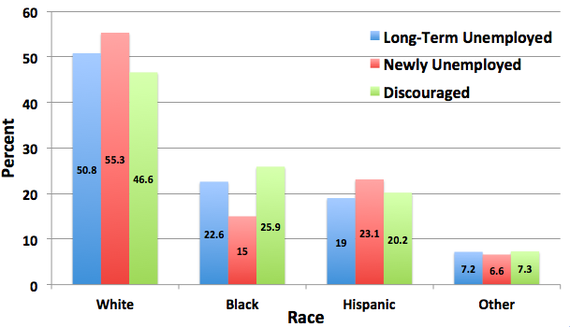Who Are the Long-Term Unemployed?
The long-term unemployed tend to be people who 1) are a little bit older, and 2) got laid off from their last job

It's been over four years since the recovery officially began, but there are still over four million people who are long-term unemployed. That's four million people who can't find work even after looking for six months or more -- four million people who can't even get companies to look at their resumes anymore.
But just who are the long-term unemployed? Well, that's the question Josh Mitchell of the Urban Institute looked at, and the answer is at once reassuring and terrifying. It turns out the long-term unemployed aren't much different from the other unemployed -- with two exceptions. They're just as educated (if not more so). And they're pretty much the same racially. But they're older. And they're unemployed, because they lost their last job -- and no, that's not as tautological as it sounds.
Let's go to the charts. Now, as you can see from the 2012 numbers below, the long-term unemployed are actually more educated than either the newly unemployed, who have been looking for work for 5 weeks or fewer, or discouraged workers, who have given up looking but still want work. Of course, some of the newly unemployed will eventually end as long-term unemployed themselves -- but not all, or most, of them. We would still expect some difference here if too little education is why companies shun the long-term unemployed. And there isn't one.
Nor is there one when it comes to race . The long-term unemployed are a little less white, a little less Hispanic, and a little more black than the newly unemployed, but not so much that any kind of bias could explain why they've had such a hard time finding work.
But it turns out there are differences between the long-term and newly unemployed beyond the obvious of how many months they've been out of work. For one, the long-term unemployed tend to be a good deal older. As you can see below, most of the newly unemployed are 25 years old or younger, while the long-term unemployed are pretty evenly distributed among age groups.
So just who ends up being long-term unemployed? Well, it depends how they got unemployed in the first place. Some people leave their jobs, and some people lose them. Some people are looking for their first job, and some people are looking for their first job in awhile. Some people are on a temporary leave, and some people are finishing temporary jobs. The newly unemployed are split pretty evenly between all of these groups. But almost half of the long-term unemployed are people who, for whatever reason, lost their last job.
It seems the stigma of getting laid off puts people near the back of the jobs line. And then, once they've been stuck at the back of that line for six months, the stigma of long-term unemployment keeps them there forever. It's a powerful, and depressing, reminder that we can't afford to ignore the short run. Sure, the economy will eventually bounce back on its own, but in the meantime, people who did nothing wrong other than working for companies that had to fire people during the worst crisis in 80 years might see their careers prematurely ended. And even now, long-term unemployment might not be falling as much as falling out of sight. Shorter and shorter benefits mean the long-term unemployed have little incentive to keep looking for work -- so they stop looking, and we stop counting them as "unemployed," and declare mission accomplished.



